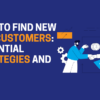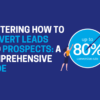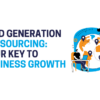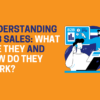There is an incredible competitive market nowadays, and acquiring new B2B customers is like an art on its own. If you are looking to start up or an established business looking to grow your business, adding new B2B clients is instrumental in driving growth. With the right strategies in place, outreach methods, and mindset, it’s entirely possible to grow your B2B customer list and build strong, lasting business relationships.
This guide contains real-life tactics and nearly perfect strategies to acquire new B2B customers, get the most out of your outreach, and close more deals.
1. Understand Your Ideal Customer Profile (ICP)
Before heading into lead generation techniques, it is necessary to define your Ideal Customer Profile (ICP). It’s a definition of what type of business would benefit the most from your solution and be of most value to your business.
The primary elements of an ICP are:
- Industry
- Company size
- Revenue
- Geographic location
- Decision-makers involved
- Common pain points
When you know who your ideal clients are, your marketing and sales are more directed and effective, and you will be more successful.
2. Develop a Targeted Prospect List
Once your ICP is set, the task then is to develop a very targeted prospect list. This needs to be a list of organisations that match your ICP and have the potential to become high-value customers.
Ways of developing a targeted list:
- Use LinkedIn Sales Navigator for company size, industry, and job title filtering.
- Purchase B2B data lists from reputable vendors.
- Utilise CRM tools for segmentation of existing data and identifying patterns.
- Monitor job boards and industry directories.
A solid prospect list is the foundation of successful outreach and lead nurturing.
3. Leverage LinkedIn for B2B Prospecting
LinkedIn is one of the most promising channels for B2B lead generation. It offers numerous possibilities to find, connect, and engage with potential customers.
Tips for LinkedIn outreach:
- Optimise your business and personal profiles to convey credibility and value.
- Join relevant groups and get involved in discussions.
- Publish thought leadership content to establish your brand as an industry thought leader.
- Use InMail and connection requests to initiate conversations.
LinkedIn is most appropriate for building relationships with decision-makers and nurturing leads in a business context.
4. Utilise Email Marketing Campaigns
Email is still an inexpensive and scalable medium for interacting with B2B customers. A well-thought-out email campaign can nurture leads and advance them through the sales cycle.
Best practices for email marketing:
- Personalise subject lines and messages based on the recipient’s business and need.
- Keep emails brief and value-focused.
- Include direct calls to action (CTAs).
- Use automation tools to schedule and segment emails.
- To optimise your strategy, track open rates, click-through rates, and conversions.
Subject line and messaging A/B testing can also strengthen response and engagement rates.
5. Create Quality Content
Content marketing is an excellent way of engaging and educating prospective B2B buyers. Good content positions your business as a thought leader and builds trust.
Content types that attract B2B customers:
- Blog posts answering common industry questions and studies of successful projects.
- Whitepapers and ebooks with in-depth information.
- Video tutorials and webinars.
- Infographics presenting trends and statistics.
Optimise the content with the keywords “how to find new B2B customers” and “how to reach B2B customers” for greater visibility.
6. Go to Industry Events and Trade Shows
Face-to-face networking is still a powerful instrument in the B2B arena. Trade shows, conferences, and trade fairs enable you to meet prospects, showcase your solution, and build personal relationships.
Benefits of industry conferences:
- Direct access to decision-makers.
- Opportunities to market your product or services.
- Competitive marketplace analysis.
- Networking and partnership building.
Even virtual events can be excellent for exposure and lead generation.
7. Work with Lead Generation Professionals
Outsourcing lead generation to the experts can allow you to grow faster and devote more time to closing deals. Lead generation companies have the resources, know-how, and networks to find B2B customers that match your ICP.
What to look for in a lead generation partner:
- Transparent processes and communication.
- Demonstrated success with B2B campaigns.
- Compliance with GDPR and data protection regulations
- Customised approach based on your industry and goals.
A good partner can act like an extension of your sales force, delivering quality leads consistently.
8. Run Targeted Paid Advertising Campaigns
Paid advertisements can give your outreach a quick shot in the arm, mainly if you’re targeting niche B2B audiences.
Channels for B2B paid advertising:
- Google Ads (Search and Display Network)
- LinkedIn Ads (sponsored content, message ads, dynamic ads)
- Facebook Ads with B2B targeting advanced.
- Industry-specific directories and publications.
Make sure your landing pages are conversion-optimised with prominent CTAs and aligned messaging.
9. Offer Free Tools or Resources
One excellent way of getting new B2B customers is to offer free tools, templates, or trials. These offers provide value upfront and encourage prospects to try out your brand.
Ideas for free offers:
- ROI calculators
- Industry benchmarks include audit templates, free trials or demos, email templates, and marketing checklists.
This strategy builds trust and allows prospects to see your value proposition at work.
10. Ask for Referrals and Use Testimonials
Referrals are one of the most consistent sources of new business. Your existing clients can be good marketers if given the right motivation.
Tips for generating referrals:
- Ask satisfied clients directly.
- Launch a referral program that rewards.
- Post success stories and testimonials on your website.
- Encourage online reviews on platforms like Trustpilot and Google.
Social proof builds credibility and can shorten the sales cycle significantly.
11. Adopt an Account-Based Marketing (ABM) Approach
ABM is a highly focused growth strategy where marketing and sales teams work together to find best-fit accounts and convert them into customers.
Steps to implement ABM:
- Identify high-value target accounts.
- Research each account thoroughly.
- Personalise content and outreach for each account.
- Align marketing efforts with sales goals.
- Use metrics to track engagement and refine strategies.
ABM helps in creating stronger relationships and higher conversion rates with the best prospects.
12. Utilise CRM and Marketing Automation Tools
Technology plays a key role in B2B customer acquisition. An effective CRM system helps manage interactions, handle leads, and coordinate communication.
Top B2B lead management tools:
- Salesforce.
- HubSpot.
- Zoho CRM.
- Pipedrive.
- Cognism.
Automation software for marketing has the ability to nurture leads in bulk and ensure no opportunity slips through the cracks.
13. Monitor and Analyse Your Results
Always aiming to improve is the key to successful B2B marketing. Monitoring your activities allows you to understand what is happening and what needs to be improved.
Key performance indicators (KPIs):
- Conversion rate.
- Cost per lead.
- Customer acquisition cost (CAC)
- Lead-to-close ratio.
- Engagement metrics (email opens, ad clicks, etc.)
Use these insights to further target your outreach, content, and overall strategy.
Incorporate Social Listening for Deeper Insights
Social listening allows you to follow and examine conversations about your industry, competitors, and brand on social media. Through this, you get to know about the needs, pin points, and views of prospective B2B buyers. Brandwatch, Hootsuite, and Mention are tools that track relevant conversations, which can be used to personalize outreach and content campaigns. Engaging in these conversations with valuable inputs builds rapport and brand recognition.
Use Retargeting to Reclaim Lost Leads
The biggest part of B2B leads won’t convert during their first visit to your website. Retargeting advertisements—served via providers like Google and LinkedIn—allow you to re-engage these visitors with targeted messaging. Advertise customer testimonials, time-limited offers, or valuable content to pull them back into your funnel. Retargeting keeps you top-of-mind and significantly increases your chances of conversion over time.
Develop a Scalable Outreach Process
As your business grows, your outreach process must also. Establish repeatable processes for lead sourcing, email sequences, social outreach, and follow-ups. Use tools like Outrach, Apollo, or Lemlist to automate and personalise large volumes of communication. This consistency in your outreach process not only saves time but also ensures each lead is receiving timely and relevant information.
Empower Employee Advocacy Throughout Your Organisation
Your team can become a large and powerful extension of your brand voice. Encourage your employees to share company news, educational content, and customer success stories through their own LinkedIn profiles. It not only broadens your audience but also generates authentic engagement. Share brief brand guidelines and pre-approved content, but also allow employees flexibility to make the messaging their own, so you achieve consistency and authenticity.
Developing strategic alliances with complementary businesses is another highly effective way of acquiring new B2B customers. By forming referral alliances or launching joint offerings, both businesses can benefit from increased exposure, shared credibility, and expanded market reach.
Building thought leadership by guest blogging on other influential industry blogs or being a podcast guest can multiply your exposure. Such outlets expose your expertise to new groups of people and help solidify your credibility. Always aim to deliver actionable tips and concrete value to encourage follow-up interest and interaction.
Video content continues to grow in the B2B realm. From behind-the-scenes or product walk-throughs, video provides a more human and personal experience with your audience. Holding interactive sessions such as LinkedIn Lives or live Q&As provides instant access to your prospects and opens the door to new leads and conversations.
A high-functioning website is at the heart of capturing B2B interest. Your site needs to say what you do, who it’s for, and how they can reach you. Establish trust by highlighting testimonials, case studies, and verification badges like certifications or client logos. Proper SEO techniques also cause your site to rank high when prospective clients search for solutions like yours.
Don’t overlook the strength of consistent follow-up. With the extended sales cycles prevalent in B2B, it may take a multitude of touchpoints prior to a lead converting. Use a well-rounded strategy—email, calls, social media, and content—so you remain top-of-mind. Persistence, along with actual value, is what will push cold prospects to loyal customers.
Utilise competitive intelligence as part of your client acquisition strategy. Analysing how your competitors obtain and retain customers—through their messaging, content strategy, and advertising—can show you gaps that you can fill. It also enables you to sharpen your positioning and create compelling, unique selling points that resonate with your market.
Integrate personal branding as a component of business development. In B2B, purchasing decisions are made based largely on relationship-building and trust. Allow your leadership and sales teams to establish a robust LinkedIn presence, engage in industry conversations, and share knowledge. When individuals are perceived as subject matter experts, it reflects positively on your overall brand.
Don’t overlook the strength of remarketing. In complex B2B decision processes, remarketing maintains your brand presence in front of decision-makers who have visited your website but did not convert. Strategically placed follow-up ads can address specific pain points and re-engage those leads into your pipeline.
Increase engagement through interactive content. Quizzes, calculators, and self-assessments not only provide instant value but also capture user data for qualification. These lead magnets align users with your sales funnel while showcasing a customised brand experience that builds early buyer journey trust. Use intent data to identify companies that are already investigating solutions in your area. By tracking activity like search terms, content consumption, and website traffic, you can engage with high-interest organisations. Targeting them at this stage with the appropriate messaging gives you a better chance of initiating conversations and closing deals sooner.
Conclusion: Embrace an Integrated, Customer-Centric Approach
Winning new B2B customers is not one silver bullet—it’s employing a multi-channel, integrated approach that’s tailored to your audience. You can either be crafting great content, building targeted lists, or investing in strategic partnerships, but every effort needs to be grounded in an understanding of your ideal client’s pain points and requirements.
At The Lead Generation Company, you should understand how important personalised outreach, data-driven campaigns, and industry expertise are. By integrating these essential strategies and tips, your business can successfully attract and win high-value B2B clients time and time again. Remember, consistency and flexibility are key.

Ryan Whyte is a Director of The Lead Generation Company where he leads a team of B2B telemarketers to deliver high-quality leads for clients. With a strong background in campaign management and a focus on driving results, Ryan is dedicated to optimising strategies that maximise client success in B2B lead generation.


















